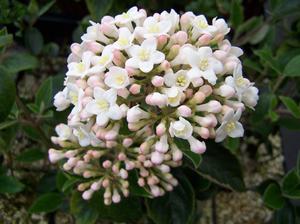View All Plants :: View All DECIDUOUS SHRUBS
Viburnum x burkwoodii 'Chenaultii'
Burkwood Hybrid Viburnum
Plant Type:
DECIDUOUS SHRUBSViburnum x burkwoodii 'Chenaultii' - This very floriferous shrub smothers itself in fragrant white snowballs April or May depending upon where you garden. 'Chenaultii is overall a tighter, denser, slower and more dwarf, rounded in outline. The foliage, too, tends to be a bit smaller than other Burkwood hybrids lasting longer into the autumn when they pick up orange to scarlet, rich red to bronze colors - some years in a mix. Many leaves remained on the shrub throughout the winter of 2013 in a dusky chocolate-bronze shade. The rounded stature of the 'Chenaultii' is much shorter and more compact than other x burkwooii selections, only growing to about 5 or so feet. Michael Dirr says that 'Chenaultii' is "an extremely confused entity". But it is nevertheless a beautiful shrub flowering slightly later than other V. x burkwoodii cultivars worthy of a spot in your landscape.
Characteristics and Attributes for Viburnum x burkwoodii 'Chenaultii'
Season of Interest (Flowering)
- Spring
Season of Interest (Foliage)
- Spring / Summer / Autumn
Autumn Interest
- Showy Buds
- Fruit / Berries / Seed Heads
- Autumn Leaf Color
Nature Attraction
- Songbirds
- Honey Bees & Native Bees
- Deer Resistant
Light
- Full Sun
Attributes
- Hedgerow
- Fragrant
- Specimen
- Screen
- Wildlife Garden
- Shrub Border
- Hedge
Growth Rate in the Garden
- Moderately Fast
Soil
- Fertile
Origins
- Garden Origin
Propagated By
- Cutting Grown
Genus Overview: Viburnum
Common Name: Viburnum
Viburnum. This genus is full of fantastic, multi-season garden worthy shrubs. Garden heroes. Spring flowers, often large and showy, many with heady sweet fragrance are arranged in cymes. Some smell of musk (Viburnum dilatatum) while others produce no fragrance at all. Flowers are followed with berries. If late season and autumn berries are desired then planting two of a species will ensure fruit set; for instance, Viburnum dilatatum 'Erie' and V. dilatatum 'Michael Dodge' will pollinate each other and produce fruit. Viburnum cassinoides is closely allied with V. nudum; but if the flowering times do not overlap then there will be no fruit. However, if you plant V. nudum 'Winterthur' in proximity with V. nudum var. angustifolium, 'Longwood', 'Moonshine' or 'Pink Beauty' berries will abound. Another interesting example is V. lantana which crosses with V. burejaeticum and vice versa. Any V. plicatum f. tomentosum selection such as 'Shasta' or 'Shoshoni' will pollinate with all other V. plicatum f. tomentosum selections like 'Copper Ridges or 'Pink Beauty'. But if you were to plant two 'Shasta' side by side with no other V. plicatum f. tomentosum in near proximity then your effort will be fruitless. As with almost all in the universe of plants there are exceptions. There is one viburnum which appears to be self-fruitful, Viburnum setigerum the Tea Viburnum. Another interesting exception to the rule is Viburnum nudum 'Pink Beauty' which is also self-fruitful - a departure from its siblings. And on the other spectrum are two I can think of off-hand that are barren, Viburnum plicatum 'Roseum' and Viburnum plicatum 'Kern's Pink'. Oftentimes, the dwarf viburnums reamin in a juvenile state and do not produce fruit. All Viburnum of any size that do produce fruit are magnificent in the late season garden. And they feed all manner of birds. Larger, denser shrubs provide cover and nesting opportunities. Nearly all Viburnum have terrific autumn foliage colors, too. Viburnums are members of Caprifoliaceae. All prefer part to full sun and fertile soils. All are cutting grown. Many thanks to Gary Ladman of Classic Viburnums who generously set us straight regarding some of the details we had originally incorrectly lauded... ya can't know everything!


